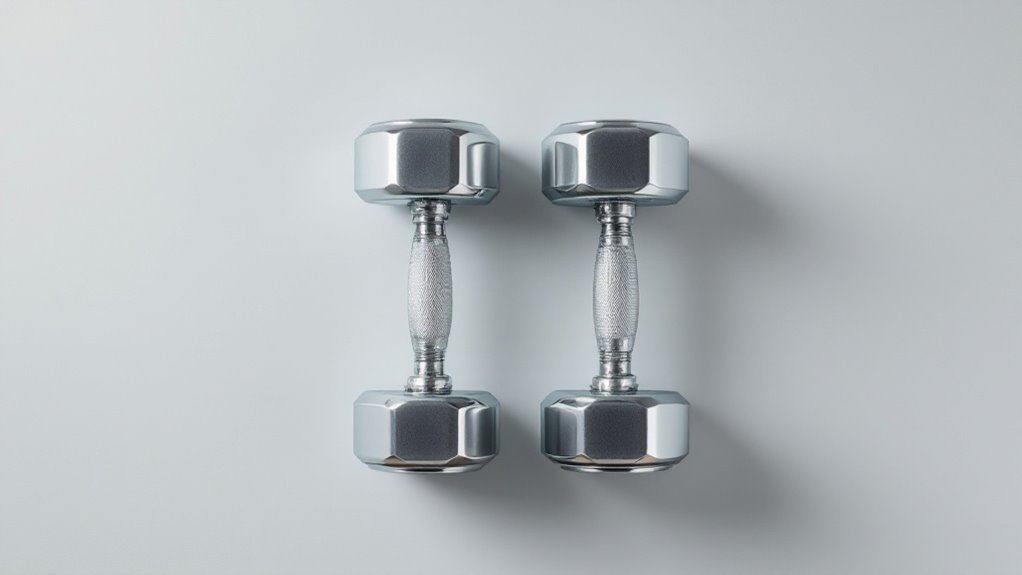Shoulder Front Raises

Front raises target the anterior deltoid muscles to build strong, defined shoulders. The exercise begins with dumbbells held at the sides, feet shoulder-width apart. With controlled movement and slight elbow bend, weights are raised forward to shoulder level, then lowered slowly. Proper form prevents swinging and maintains core stability. Multiple equipment options include dumbbells, resistance bands, plates, or cables. Understanding proper technique reveals the full potential of this foundational shoulder exercise.
Key Takeaways
- Front raises target the anterior deltoid muscles by lifting weights forward to shoulder height with controlled movement.
- Stand with feet shoulder-width apart, hold weights at sides, and maintain slight elbow bend throughout exercise.
- Avoid swinging motions and raising weights above shoulder level to prevent rotator cuff injuries.
- Begin with 2-3 sets of 12-15 reps using lighter weights to master proper form.
- Exercise variations include using resistance bands, weight plates, cable machines, or kettlebells for different training stimuli.
How to Perform Perfect Front Raises

When executed correctly, front raises are one of the most effective exercises for building strong, defined shoulders and improving upper body stability. The movement targets the anterior deltoid muscles while engaging core stabilizers for total control.
To perform perfect front raises, start by standing with feet shoulder-width apart, holding dumbbells at your sides with palms facing your thighs.
Keeping arms straight but not locked, raise the weights forward and up until they reach shoulder level. Maintain control throughout the movement, avoid swinging or using momentum, and lower the weights slowly back to the starting position.
For optimal shoulder development, consider alternating front raises with seated dumbbell presses to target all three heads of the deltoid muscle group.
Common Form Mistakes to Avoid

Despite proper front raise form being straightforward to learn, several common mistakes can reduce the exercise's effectiveness and potentially lead to injury.
- Swinging or using momentum instead of controlled movement – this alters focus from the deltoids and reduces muscle involvement.
- Raising dumbbells above shoulder level, which places unnecessary stress on the rotator cuff and can lead to impingement.
- Locking the elbows during the movement rather than maintaining a slight bend.
- Poor posture, including arching the back or leaning backward to compensate for weight that's too heavy.
Focusing on compound movements first can help develop the foundational strength needed for isolation exercises like front raises.
Variations and Equipment Options

Although the standard dumbbell front raise is highly effective, fitness enthusiasts can choose from several variations and equipment options to keep their shoulder workouts fresh and challenging.
Resistance bands offer a unique tension curve and portable solution for front raises. Plate raises utilizing weight plates provide a different grip stimulus, while cable machines guarantee constant tension throughout the movement.
Kettlebells add an element of stabilization, and barbell front raises allow for heavier loads.
For advanced lifters, alternating arms, incorporating tempo changes, or performing front raises on an incline bench can increase difficulty and target different aspects of the anterior deltoid.
Following progressive overload principles ensures continued muscle growth as you master each variation.
Tips for Progressive Overload and Training Volume

Successful progression with shoulder front raises requires a systematic approach to both weight increases and training volume management. Proper programming helps prevent plateaus while minimizing injury risk.
- Start with 2-3 sets of 12-15 reps, increasing weight by 2-5 pounds when all sets can be completed with perfect form.
- Progress to 3-4 sets of 8-12 reps once foundational strength is established.
- Implement micro-loading using fractional plates or resistance bands for smoother progression.
- Track weekly volume, aiming to increase total reps or weight by 5-10% every 2-3 weeks while maintaining proper technique and tempo.
Focus on developing a strong mind-muscle connection to maximize hypertrophy during each rep of the exercise.
Frequently Asked Questions
Can Front Raises Help With Shoulder Impingement?
Front raises typically aren't recommended for shoulder impingement as they can actually worsen the condition by increasing compression in the subacromial space.
Instead, individuals with shoulder impingement should focus on exercises that strengthen the rotator cuff and improve scapular stability.
Physical therapy, proper posture, and exercises like external rotations and wall slides are more beneficial for addressing impingement symptoms.
Should I Do Front Raises Before or After Overhead Pressing?
For ideal shoulder training, perform overhead pressing movements before front raises.
This sequence allows maximum strength and power output during the more complex, compound pressing movement.
Front raises, being an isolation exercise, are better suited for the latter part of the workout when the shoulders are pre-fatigued.
This approach guarantees the best performance on the primary movement while still getting quality isolation work.
How Long Should I Rest Between Sets of Front Raises?
Rest periods between sets should be tailored to your training goals.
For muscle growth and endurance, keep rest intervals at 30-60 seconds. If focusing on strength with heavier weights, extend rest to 90-120 seconds.
Listen to your body's signals – when breathing returns to normal and muscles feel ready for action, it's time for the next set.
Track rest times to maintain consistency.
Are Front Raises Necessary if I Already Do Military Presses?
Military presses effectively target the anterior (front) deltoids as a compound movement, making front raises often redundant for basic shoulder development.
However, front raises can be beneficial for specific goals like isolation work, pre-exhaustion techniques, or aesthetic refinement.
For most lifters, especially beginners, military presses alone provide sufficient anterior deltoid stimulation when performed with proper form and progressive overload.
What Muscles Besides Shoulders Do Front Raises Target?
Front raises primarily target the anterior (front) deltoid but involve several secondary muscle groups.
The exercise activates the upper chest muscles, particularly the clavicular head of the pectoralis major. The trapezius and serratus anterior work as stabilizers during the movement.
Core muscles, including the rectus abdominis and transverse abdominis, engage to maintain proper form and prevent excessive back arch.
Final Thoughts
Front raises are the cornerstone of building boulder-like shoulders when performed with proper form and progression. By avoiding common mistakes, exploring equipment variations, and following smart training principles, lifters can enhance their deltoid development while minimizing injury risk. Whether using dumbbells, plates, or resistance bands, this fundamental exercise deserves a prime spot in any extensive shoulder training program.


